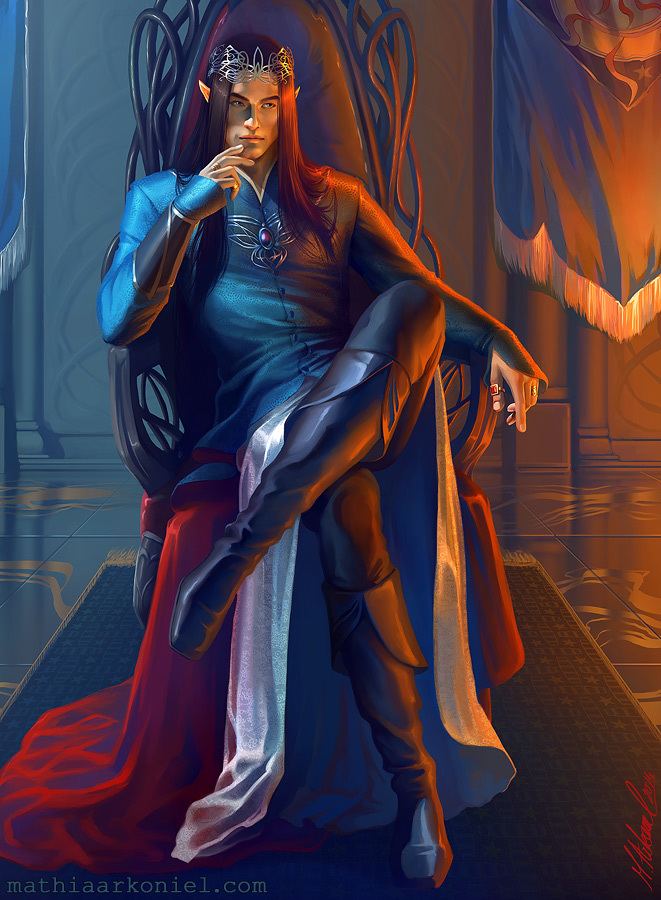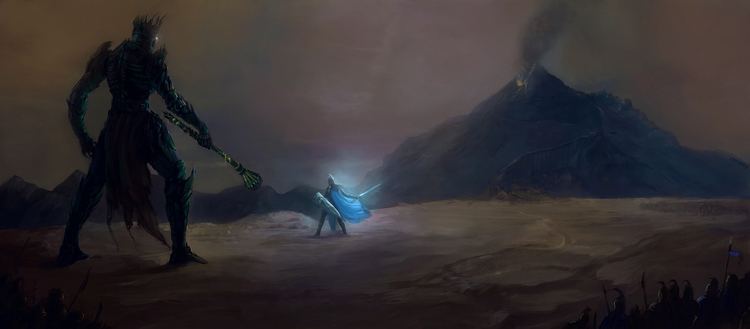Aliases Nolofinwë, Aracáno Weapon Ringil Spouse Anairë | Race Elves Spouse Anairë Book The Silmarillion | |
 | ||
Title King of Hithlum, High King of the Ñoldor Children Fingon, Turgon, Aredhel, Argon Similar Fëanor, Morgoth, Fingon, Maedhros, Finarfin | ||
Fingolfin ([fiŋˈɡolfin]) is a fictional character in J. R. R. Tolkien's legendarium, appearing in The Silmarillion.
Contents
Internal history

Fingolfin was a High King of the Noldor in Beleriand, second eldest son of Finwë, full brother of Finarfin, and half-brother of Fëanor, who was the eldest of Finwë's sons. He founded the House of Fingolfin which ruled the Noldor in Middle-earth. His wife was Anairë and his children were Fingon, Turgon, Aredhel and Argon. Fingolfin was said to be the strongest, most steadfast, and most valiant of Finwë's sons. His name in Quenya — one of Tolkien's fictional languages — was Nolofinwë, or "wise Finwë." This was his father-name; his mother-name was Aracáno, or "High Chieftain", the same name as his youngest son Argon.

Fingolfin was born to Finwë's second wife, Indis, after Míriel died, as was Finarfin. While they lived in Aman, there was always strife between the sons of Indis and the son of Míriel (Fëanor), mostly due to Melkor's treachery. However, Fingolfin would seek to forge a better relationship with Fëanor at every chance. Even after Fëanor threatened him with swords and was banished from Tirion, Fingolfin forgave him and tried to mend their relationship. This occurred very soon before destruction of the Two Trees and the Darkening of Valinor. After this event and Fëanor's decision to leave Aman, Fingolfin chose to follow him into exile, so as not to abandon his people.

Fingolfin led the largest host of the Noldor when they fled Aman for Middle-earth, even though he thought this unwise; he did not want to abandon his people to Fëanor. His followers participated in the Kinslaying at the Havens, but only because they arrived after the battle was underway not knowing that Fëanor was the aggressor. He was the one who took them across the ice of the Helcaraxë, and soon after, at the rising of the Sun, he came to the gates of Angband and smote upon them, but Melkor — now known as Morgoth — stayed hidden inside. Fingolfin and the Noldor then came to the northern shores of Lake Mithrim, from which the Fëanorian part of the host had withdrawn.
His son Fingon rescued Maedhros, son of Fëanor, who in gratitude waived his claim to kingship: thus, Fingolfin became High-King of the Noldor. He then ruled from Hithlum, by the northern shores of Lake Mithrim.
After defeating the Orcs in the Dagor Aglareb, Fingolfin maintained the Siege of Angband for nearly 400 years. But the Siege was ended by Morgoth's sudden assaults in the Dagor Bragollach, the Battle of Sudden Flame, and many peoples of Beleriand fled. When Fingolfin learned of this, and received false report that his allies had been routed on all fronts, he became filled with wrath and despair. He immediately took his horse Rochallor and sword Ringil, and rode alone to Angband. All enemies fled from him, fearing his anger, and mistaking him in his fury for Oromë, the Vala patron of hunters.
He smote the gates of Angband and challenged Morgoth to single combat. Though Morgoth feared Fingolfin (of all the Valar, Morgoth was the only one to know fear), he had to accept the challenge — or face shame in the eyes of his servants. Seven times Fingolfin wounded Morgoth and seven times Morgoth cried in pain, and seven times the host of Morgoth wailed in anguish, but he could not be slain for he was one of the Valar.
Whenever Morgoth attacked, Fingolfin would evade, avoiding Morgoth's weapon Grond, the hammer of the underworld, as it would crack the ground so violently smoke and fire darted from the craters. Eventually, however, Fingolfin grew weary and stumbled on a crater. Then Morgoth pinned Fingolfin with his foot, and killed him, but not before he, with his last act of defiance, hewed at Morgoth's foot. Morgoth, from thence forward, always walked with a limp. An enraged Morgoth sought to desecrate the body of the valiant king but Thorondor, Lord of Eagles flew down and raked Morgoth's eyes, and carried Fingolfin's body away to be placed on a cliff overlooking Gondolin. Later his son Turgon built a cairn over the remains of his father.
Concept and creation
Fingolfin is among those major characters whom Tolkien, who also used to illustrate his writings, supplied with a distinct heraldic device.
Fingolfin in songs
The song "Time Stands Still (At the Iron Hill)" of the German power-metal band Blind Guardian tells the story of the fight between Morgoth and Fingolfin.
